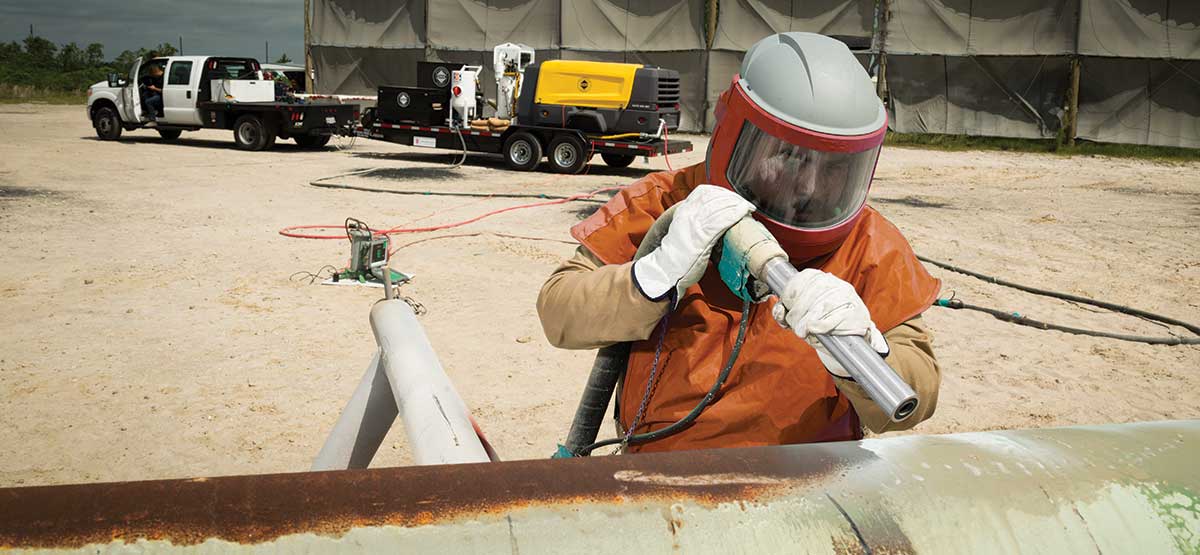You’re currently viewing the Americas website.
You’re currently viewing the Americas website.
Would you like to switch countries or language?Blast Abrasives
Topics
Waterjet Cutting
Topics
Resources
Categories
Types
Categories
Topics
Abrasive Blasting Tech Tips English Global
Advantages of finer grade garnet
Many blasting and coating specialists default to using a 30/60 mesh garnet or a coarser garnet for surface cleaning and preparation.
A source of efficiency that is often overlooked is selecting the correct garnet grain size to achieve the desired surface profile. The size of the abrasive particles can significantly influence surface cleaning rates, as the number of grains in standard garnet grades can vary from two to six million per kilogram.
This article outlines the advantages of finer versus coarser grade garnet on surfaces such as mill scale, lightly rusted areas and light build coatings. It also provides examples of industry applications that can benefit from using finer grade garnet, and in comparison, applications where coarser grades are more appropriate for use.
Furthermore, some practical aspects to consider when choosing the garnet grain size for a desired surface profile are explored.
Benefit of Using a Finer Abrasive
When blasting with garnet, larger garnet grains facilitate deeper indentations than finer garnet grains but produce fewer impacts across any given area. This is due to fewer grains hitting the surface area per square metre. The use of a finer grade with a higher grain count per kilogram will produce more impacts per square metre, resulting in more efficient blasting performance on lightly rusted coatings, mill scale and heavy corrosion.
Finer garnet grains produce a more uniform surface profile, cleaner finish, higher peak density and are able to sweep out rust within tight crevices, in addition to the benefit of higher blasting rates.
The illustrations below demonstrate the difference in impact produced by coarser versus finer garnet grains, and the resulting surface finish, on a coated metal.

Selecting the Right Garnet Abrasive
Whatever the required finish, there will be an appropriate garnet grain size for the job. For general applications when a surface profile above 75 microns is specified, the 30/60 mesh garnet is generally considered to be the ideal industry standard garnet grade. Finer garnet grades range from 80 to 120 mesh, and ultra-fine garnet grades range from 200 to 300 mesh size.
When selecting your garnet grade, the most important criteria should be the physical nature of the required finish (i.e. surface profile and standard of cleanliness). For example, when surface profiles above 75 microns are required, a relatively coarse garnet may be considered appropriate. However, most of the time, the purpose of blast cleaning is not to simply aggressively attack the surface. The operator should aim to achieve the required surface profile without unduly exceeding the surface preparation requirement.
Finer grain garnet has the versatility to achieve desired results for specialised applications by reducing the potential of undue damage to workpieces. The use of finer grains at the appropriate nozzle pressure will facilitate control and efficiency. The same principle applies to delicate substrates like fiberglass and aluminium.
In the next edition, we will talk about the application examples for finer grain garnet.
 By John Halewood, Business Development Manager
By John Halewood, Business Development Manager
 GMA ToughBlast™
GMA ToughBlast™ GMA SpeedBlast™
GMA SpeedBlast™ GMA NewSteel™
GMA NewSteel™ Oil & Gas
Oil & Gas Industrial Fabrication & Maintenance
Industrial Fabrication & Maintenance Marine & Ship Building
Marine & Ship Building TruCost Blast Calculator
TruCost Blast Calculator Product Selector
Product Selector Brochure | GMA Garnet Blast Abrasives
Brochure | GMA Garnet Blast Abrasives News: GMA's Roadmap to Sustainability
News: GMA's Roadmap to Sustainability GMA ExcelCut
GMA ExcelCut GMA ProCut™
GMA ProCut™ GMA ClassicCut™
GMA ClassicCut™ Metal fabrication
Metal fabrication Glass cutting
Glass cutting Stone cutting
Stone cutting Case Study | GMA ClassicCut | Smith and Nephew
Case Study | GMA ClassicCut | Smith and Nephew Why is Garnet the preferred abrasive in Waterjet cutting?
Why is Garnet the preferred abrasive in Waterjet cutting? Water Filtration
Water Filtration Rubber Fillers
Rubber Fillers Anti-skid Products
Anti-skid Products Ilmenite Sand
Ilmenite Sand Pyroxene
Pyroxene Rutile
Rutile